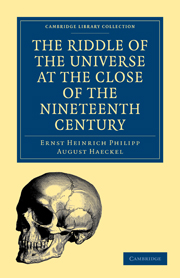Book contents
- Frontmatter
- Contents
- PREFACE
- AUTHOR'S PREFACE
- CHAPTER I THE NATURE OF THE PROBLEM
- CHAPTER II OUR BODILY FRAME
- CHAPTER III OUR LIFE
- CHAPTER IV OUR EMBRYONIC DEVELOPMENT
- CHAPTER V THE HISTORY OF OUR SPECIES
- CHAPTER VI THE NATURE OF THE SOUL
- CHAPTER VII PSYCHIC GRADATIONS
- CHAPTER VIII THE EMBRYOLOGY OF THE SOUL
- CHAPTER IX THE PHYLOGENY OF THE SOUL
- CHAPTER X CONSCIOUSNESS
- CHAPTER XI THE IMMORTALITY OF THE SOUL
- CHAPTER XII THE LAW OF SUBSTANCE
- CHAPTER XIII THE EVOLUTION OF THE WORLD
- CHAPTER XIV THE UNITY OF NATURE
- CHAPTER XV GOD AND THE WORLD
- CHAPTER XVI KNOWLEDGE AND BELIEF
- CHAPTER XVII SCIENCE AND CHRISTIANITY
- CHAPTER XVIII OUR MONISTIC RELIGION
- CHAPTER XIX OUR MONISTIC ETHICS
- CHAPTER XX SOLUTION OF THE WORLD-PROBLEMS
- INDEX
CHAPTER II - OUR BODILY FRAME
Published online by Cambridge University Press: 05 August 2011
- Frontmatter
- Contents
- PREFACE
- AUTHOR'S PREFACE
- CHAPTER I THE NATURE OF THE PROBLEM
- CHAPTER II OUR BODILY FRAME
- CHAPTER III OUR LIFE
- CHAPTER IV OUR EMBRYONIC DEVELOPMENT
- CHAPTER V THE HISTORY OF OUR SPECIES
- CHAPTER VI THE NATURE OF THE SOUL
- CHAPTER VII PSYCHIC GRADATIONS
- CHAPTER VIII THE EMBRYOLOGY OF THE SOUL
- CHAPTER IX THE PHYLOGENY OF THE SOUL
- CHAPTER X CONSCIOUSNESS
- CHAPTER XI THE IMMORTALITY OF THE SOUL
- CHAPTER XII THE LAW OF SUBSTANCE
- CHAPTER XIII THE EVOLUTION OF THE WORLD
- CHAPTER XIV THE UNITY OF NATURE
- CHAPTER XV GOD AND THE WORLD
- CHAPTER XVI KNOWLEDGE AND BELIEF
- CHAPTER XVII SCIENCE AND CHRISTIANITY
- CHAPTER XVIII OUR MONISTIC RELIGION
- CHAPTER XIX OUR MONISTIC ETHICS
- CHAPTER XX SOLUTION OF THE WORLD-PROBLEMS
- INDEX
Summary
Fundamental importance of anatomy. Human anatomy. Hippocrates, Aristotle, Galen, Vesalius. Comparative anatomy. Georges Cuvier. Johannes Müller. Carl Gegenbauer. Histology. The cellular theory. Schleiden and Schwann. Kölliker. Virchow. Man a vertebrate—a tetrapod—a mammal — a placental — a primate. Prosimiæ and simiæ. The catarrhinæ. Papiomorphic and anthropomorphic apes. Essential likeness of man and the ape in corporal structure.
All biological research, all investigation into the forms and vital activities of organisms, must first deal with the visible body, in which the morphological and physiological phenomena are observed. This fundamental rule holds good for man just as much as for all other living things. Moreover, the inquiry must not confine itself to mere observation of the outer form; it must penetrate to the interior, and study both the general plan and the minute details of the structure. The science which pursues this fundamental investigation in the broadest sense is anatomy.
The first stimulus to an inquiry into the human frame arose, naturally, in medicine. As it was usually practised by the priests in the older civilizations, we may assume that these highest representatives of the education of the time had already acquired a certain amount of anatomical knowledge two thousand years before Christ, or even earlier. We do not, however, find more exact observations, founded on the dissection of mammals, and applied, by analogy, to the human frame, until we come to the Greek scientists of the sixth and fifth centuries before Christ—Empedocles (of Agrigentum) and Democritus (of Abdera), and especially the most famous physician of classic antiquity, Hippocrates (of Cos).
- Type
- Chapter
- Information
- Publisher: Cambridge University PressPrint publication year: 2009First published in: 1900

